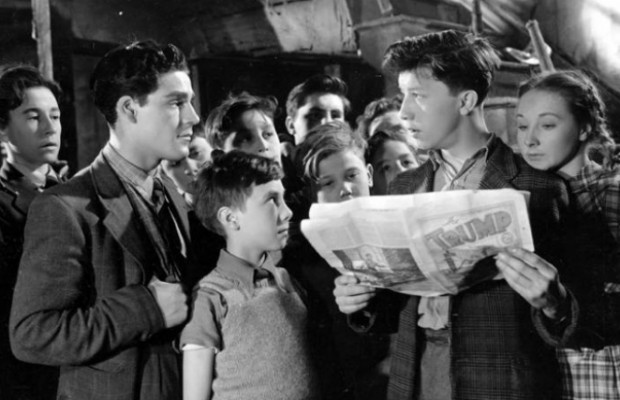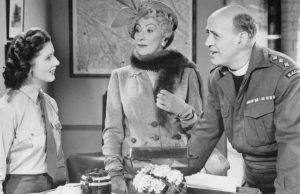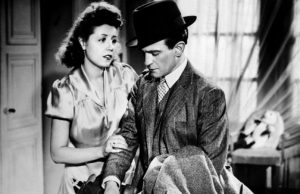Hue and Cry (1948)

Boundary Lines, Steel, & Hue and Cry
6th Showing, March 6th, 1949, 8:15 pm
Royal Ontario Museum Theatre
Boundary Lines (USA l947) Kodachrome 10 minutes Source: Toronto Public Library
Produced by International Film Foundation
Written and directed: Philip Stapp
Music: Gene Forrell
Important as a social document and a novel experience in film making, this colour film employs new techniques to build up a well-reasoned argument and appeal for individual, national and international co-operation in an atomic age. Technically superb, the film uses a wealth of devices in an intelligent and imaginative manner to illustrate simply and clearly, point by point, that “a line is only an idea,” it can be what we make it. In addition to the conventional animation used, Boundary Lines returns to lantern slide technique and by dollying in and out on parts of still pictures, develops something new in the way of method. In addition to this extension of the original source of the animated film, the maker of Boundary Lines has utilized some elements of the less radical school of modern painting and from these elements has developed symbols. He has chosen to animate these symbols rather than to animate the figures, as in the Disney convention. This original technique, combined with an effective commentary and expressive music played by only a few instruments results in a stimulating film.
Steel (Great Britain 1948) Technicolor Source: NFS Ottawa
Produced by Film Producers Guild for the British Council
Written and Directed: Ronald H.Biley
Associate Producer: A. Frank Bundy
Music: Dr.Clifford with the London Symphony Orchestra conducted by Muir Mathieson
Photography: Jack Cardiff
Commentary: John Laurie
An awe-inspiring description of the steel industry in Britain, photographically this is a very interesting film. The cinematographer, Jack Cardiff (famous for his colour photography in such films as The Raiders, Black Narcissus, Scott of the Antarctic, The Red Shoes) was, on the one hand, able to dispense with conventional lighting equipment and photograph some scenes by the light of incandescent steel. On the other hand, he was faced with the problem of pouring onto the dark and dingy black sections of the steel plant unheard of amounts of illumination, in order to make those parts reasonably bright as compared to the glowing metal. It is very probable that the amount of lighting equipment used on such scenes would total more than twice the power of all the display searchlights which are used at the CNE each summer.
Boundary Lines was photographed in Kodachrome and the print we are using is a Kodachrome duplicate. Steel was photographed in 55 mm (three strip Technicolor). The print we are seeing is a genuine l6 mm Technicolor print with three superimposed dye images, similar to colour retragravure in process, while the sound track is conventional black and white. It such be interesting to members to take note of the rather different effects due to “the colour balances” of the two films. It should be borne in mind that the sound track of Boundary Lines is in colour and hence renders the sound rather differently to that of the silver image track of the Steel film.
Hue and Cry (Great Britain 1948) 76 minutes Source: J. Arthur Rank 16 mm Ltd.
Directed by Charles Crichton
Screenplay by T.E.B. Clarke
Music composed by Georges Auric played by the London Philharmonic
Director of Photography: Douglas Slocombe
Cast: Alastair Sim, Jack Warner, Valerie White and “The Blood and Thunder Boys.”
We are indebted to the J. Arthur Rank Organisation for permission to screen Hue and Cry to our members. Because the film ”begs to differ” it has not been shown commercially in Toronto. A film with a fresh approach and many original touches, it should have wide appeal to both adults and teen agers. Perhaps our evaluations will aid in bringing the film before the Toronto public at an early date.
An experiment in British film making Hue and Cry is a fantasy about children. It has a similarity to the German film Emil Und Die Detektive. The fantastic plot involving hundreds of London’s school children, a group of black marketeers, and a writer of penny dreadfuls is set against the natural background of London’s ruined buildings and is treated in a manner which is marked by naturalism throughout.
About the making of this film, its director Charles Crichton writes in Penguin Film Review Number Seven:
“The story opened with an amazing coincidence, Joe reading a serial in a boy’s paper and then finding himself confronted with the very events of which he was reading; it continued quickly from one improbable event to another, picking up in its course one or two extraordinary characters. But it was the improbable, the exaggerated and the extraordinary with which the story dealt, but never the impossible. Later it developed moments of genuine suspense and drama which we knew would fail if we had not already created in the minds of the audience a belief in the characters of the children, and at least a tongue-in-cheek acceptance of our plot. For this reason the treatment of the subject had to emphasise the possibilities rather than the impossibilities, our camera angles had to be conventional, our settings realistic with as many honest-to-God exteriors as possible, and above all our children had be children, genuine flesh-and-blood kids. In other words, we had to emphasise the absurdity of our story through the realism with which we stated it, to enrich our fantasy by the conviction of its telling …”
The children were recruited from everywhere — from schools and jobs, from Youth Clubs and the Boy Scouts, from casting agents. They came from all classes – from the rawest of Cockneys to more sophisticated young men who were intent on becoming actors. Their ages ranged from fourteen to eighteen, and each, therefore, was at a different stage of development. Their earnestness strengthened
our plot in a way we had not considered possible, because they believed our plot, in our story. It would be difficult for an adult to take seriously the idea of a gang of crooks using a kids’ paper as a means of communication. But these boys believed it possible and by their belief made it possible. They stressed the humour of the situation and emphasised, through realism, its absurdity …”
In the fast moving section (when boys from all ever London, rushpell-mell through the familiar streets to over-power the crooks by sheer weight of numbers) we might have used the camera with greater freedom, underlining the preposterous nature of the story by preposterous set-ups. We might have built exaggerated and stylised sets in the studios. But we followed the idiom we had planned and tried to get our fun and our fantasy out of the situation itself and not out of treatment. We set out to be as convincing as we could be, we really did release torrents of boys onto an unsuspecting London, we made them run in straggling mobs. If we needed twenty-eight boys to be disgorged from one taxi, we really did cram twenty-eight bays into one taxi. We used no back projection and not studio tricks …My argument is that the gang brought conviction to a fantasy which needed to carry conviction … The technique of some of the Blood and Thunder Boys may have been rough but their untutored imaginations provided something else which could only otherwise have been brought to us by an actor of consummate skill.”
***
Please use an Evaluation form (obtainable in the lobby) to indicate your opinion of Hue and Cry and deposit it in the box in the lobby after the performance or mail it to 235 Grenadier R0ad. Two post-screening meetings of Members and Directors have taken place at Diana Sweets. These were informal and planned for the purpose of introducing ourselves to members and getting reactions to films. A few members have indicated their interest in holding discussions on the films. There are many problems attached to such a worthwhile project. The Directors are giving the matter study and before the Season is terminated hope to make tentative experiments in this direction, or at least plan for discussions next season.
NATIONAL FILM SOCIETY, TORONTO BRANCH
formerly
TORONTO FILM STUDY GROUP
First Toronto Showing
We are pleased to announce that the British film, Hue and Cry, voted the most popular film shown during our 1948-49 season will at last be shown commercially in Toronto.
This experiment in British film-making will run at the Odeon Christie Theatre (St. Clair and Christie) August 25, 26 and 27.
Because the film begs to differ, there was hesitation on the part of theatre managers to book it. Our members’ evaluations of Hue and Cry commended its refreshing approach and originality and emphaiszed that it should have wide appeal to all types and ages of audiences.
We are vitally interested in seeing such experiments in film-making supported and think that our members will want to recommend Hue and Cry to their friends, or see it again themselves.
Members will recall that Hue and Cry is a fantasy about children. It involves hundreds of London’s school children, a group of black market villains and a writer (Alastair Sim) of penny-dreadfuls, set against the natural background of London’s ruined buildings.









yes as it says above lots of normal London (Cockney Kids) were recruited for the film including my late Dad… Albert Ernest Hughes (aka Wally) in the film. It was his one and only film and got the part because he could do some gymnastics he was the kid on the rings in the gangs hide out. he’s big line in the film was ‘maybe it’s some sort of a code?’ obliviously it’s a favourite film with the Hughes family, hope everyone enjoyed it and a bit of London that is no longer.
Thanks for sharing that Keith! That’s an amazing anecdote about an amazing film!